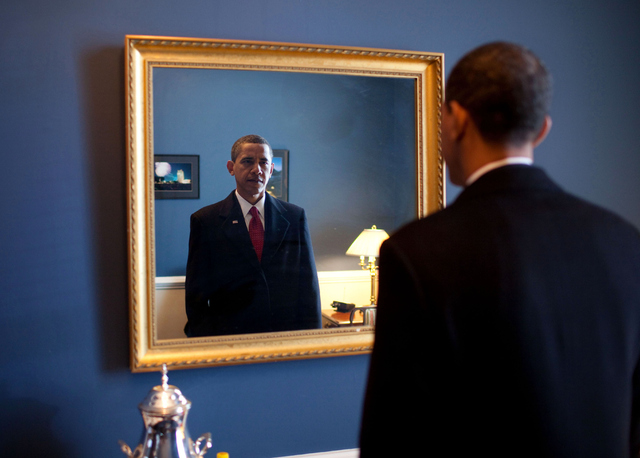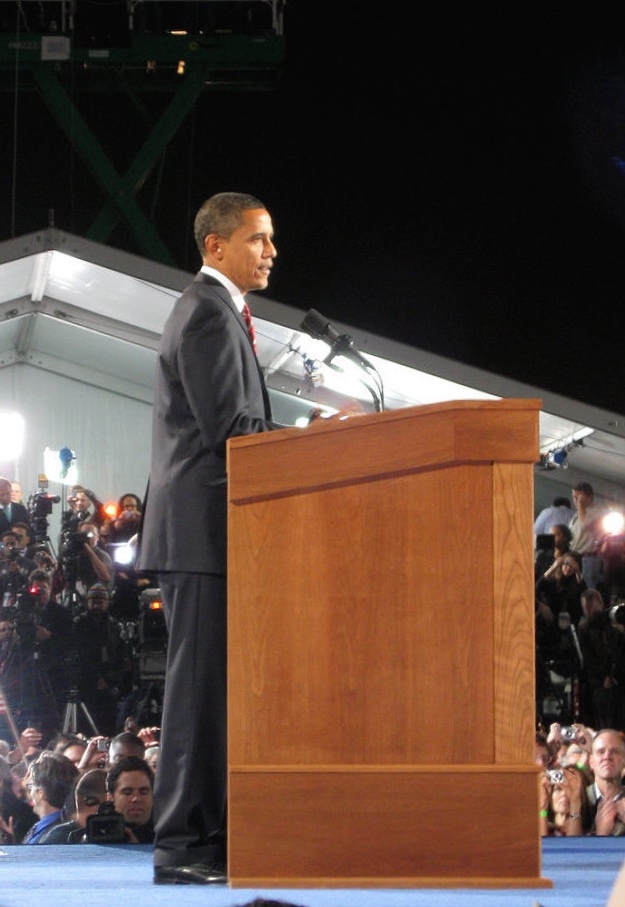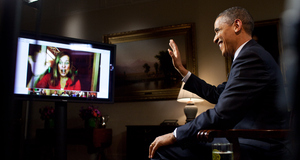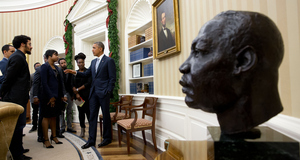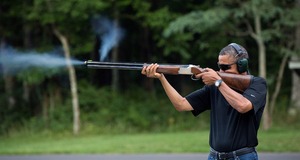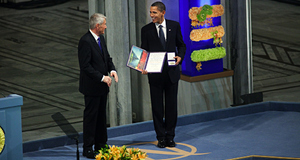The Obama PresidencyDoes "Obamaism" Exist? An Analysis of Ideology and its Place in the Obama Era
By
2015, Vol. 7 No. 02 | pg. 1/3 | »
IN THIS ARTICLE
KEYWORDS
Philosophers have been grappling at what characterizes the manifestation of what we call “ideology” for some time now. Is it based in some written or spoken manifesto? Or is it much murkier than that— a frame for what we think in the same way language or culture might? And what of its prophets? How do we determine the ideological nature of an individual and the legacy it might entail? The name “Obama” excites such unusual passion that it is hard not to conceive his visage, already branded across highly colorful paraphernalia, as a symbol of this decade. But for the most part, his “beliefs” were expounded not so much by himself as they were drawn in caricature by his most ardent enemies and supporters. The closest Obama came to the creation of an ideology was in 2008 with his first candidacy. There we observed both a cerebral foundation of principles and a visceral glamour that was never repeated afterwards. From then on, Obama’s ideology was rarely felt outside of the policy-making circles that surrounded him. Either for lack of good communication or the submerged nature of what he attempted to change, only the sketchiest and most distorted images of what Obama wished to represent was ever delivered to the public. Obama was also content to compromise, to share, even to continue the agendas of his predecessors. In order to embody democratic values, centrist bipartisanship was a key virtue he espoused.
Just prior to taking the oath of office, January 20th, 2009, President-Elect Obama has one last look in the mirror. Photo: Pete Souza/White House.
“This is our moment. This is our time…to restore prosperity and promote the cause of peace; to reclaim the American Dream and reaffirm that fundamental truth— that out of many, we are one; that while we breathe, we hope, and where we are met with cynicism and doubt, and those who tell us that we can’t, we will respond with that timeless creed that sums up the spirit of a people: Yes we can.” – Pres. Obama's 2008 Acceptance Speech. Photo: Gabbec CC-2 Obama employed rhetoric of a “fair” America but wholeheartedly embraced market competition provided it played by the rules. Though he showed a conscious knowledge of the divisions of America he refused to confront these directly out of fear of stoking them. Issues of class only began to creep into his campaign rhetoric in 2012 following pressure from his base. He rejected Bush’s policy on war not because he was anti-war but because he believed in “smart” war— a moniker the Iraq war failed to embody to Obama’s taste. He was a strong believer in multilateralism, engaging in foreign policy with a team of willing allies, rather than charging in with or without help as Bush and Clinton tended to threaten. His speeches abroad were as much about respecting culture and sovereignty as they were about the gospel of liberal markets and democracy. One’s immediate impression would be to place Obama as centrist, a classic liberal in his espousal of both the idea of democracy and free trade. Yet, failure or even unwillingness to communicate would be the greatest plague to a president who entered office promising an end to a closed off Washington elite. Allowing the grandeur of 2008 to be left behind and narrative control unattended would be the crucial element of what allowed outsiders to caricaturize him so thoroughly and throw real Obamaism into obscurity. The Apparatus: The Twin Faces of IdeologyTo begin, we must of course define what an ideology even is. It is quite a protean concept and like faith and imagination it can be difficult to grasp. The reason ideologies have been so broad and malleable throughout history is because it functions on two levels: the cerebral and the visceral. Louis Althusser, a leading philosopher on matters pertaining to ideology, would say it is the divide between the individual’s personal relationship to the idea and the institutionalized forms the idea may take. 1 If the cerebral is the textbook version of an idea—the demystification of the dream to better apply it in the material realm— the visceral form of the idea exist purely in the mind of the individual who characterizes it through his or her own experiences and relationships to life. If the cerebral version of fascism is the basic understanding of being nationalist, anti-Marxist, and celebrating heroism through arms, the visceral would be the fraternal relationship one develops when participating in the fascist rituals, feeling included in a special way when walking around with fascist paraphernalia, the strange sense that when the leader is speaking with broad words that somehow they apply specifically to oneself. Ideology is closely tied to symbols, to a performance. A good example is the hold that capital has on those of us that assign value to money. Money, paper or metal, suffers the effects of use and its material body ages and changes with time just as Obama does. But in the social environment of the market, we choose to treat the money as a substance which time by itself cannot change in value. In our minds, money is not simply the natural matter of which it is made but the very symbol of material value itself.2 This is how we accept contradictory statements like “Yes, Obama is a politician like the rest. But there is still something about him…” Complete naiveté is not a vital criterion to having ideology— feelings like cynicism allow us to hold conflicting views like this. One can have a dark view of the broad political class and still feel elation or interest in individual candidates for various personal reasons.3 Ideology first and foremost survives by being reproduced by individual subjects.4 It is the imaginary way in which individuals interact with the real relations in which they exist. The symbols, the leader’s charisma, the institutions on which the ideology’s power rely on in the actual world depend heavily on the individual subject’s willingness to reproduce or at least participate in all or aspects of the dominant ideology. The Catholic Church, for all of its brooding imagery and high ceremony, has to accept that each subject participates for individual reasons not necessarily related to unconditional faith. One prays for faith, for a sense of duty, for some other goal or ideal he or she ascribes to the act of being in church.5 It is to the system’s benefit to accommodate these contradictions and diverse sentiments to survive. Obama’s supporters in both 2008 and 2012 came from very diverse walks of life. Obama’s rhetoric and image were from the start difficult for him to create since it had to be so elastic as to broadly appeal to something all of these voters supposedly had in common.6 What was important was that this message was accepted, that the voters participated, and that eventually the ideology would be deployed through the federal and state institutions, now worked into the fabric of American life. Implementation: The Making of a SymbolObama came to the public view in his famous 2004 DNC keynote address. “My parents shared not only improbably love,” he said. “They shared an abiding faith in the possibilities of this nation…because in a generous America you don’t have to be rich to achieve your potential.” To thunderous applaud Obama delivered a highly inclusive and optimistically nationalist speech that would feed his persona as a uniter: “There is not a liberal America and a conservative America…There is not a black American and a white America and a Latino America and an Asian America— there’s the Unites States of America…we are all one people, all of us pledging allegiance to the Stars and Stripes…Do we participate in a politics of cynicism or do we participate in a politics of hope?”7 This is nationalistic not in today’s more common sense of nostalgia, looking back on symbols and key events of historical importance to create a golden narrative, that things were better back then. It is a forward looking nationalism, rejecting divisions within society to melt them all within the proud march of patriotism, a hopeful gaze to the future. Obama is attempting to rekindle faith in the American Dream, an ideal that in 2007, with the mortgage bubble crisis and the Great Recession that followed, was radically being called into question. Obama’s bestselling publication, The Audacity of Hope established this man and his relationship to his country in a way that many Americans needed to hear. The Audacity of Hope is a broad portrait of Obama’s views on a range of socio-political topics. The themes of bipartisanship, a return to that better time when politicians frequently worked on projects across the aisle, are the themes of the very first chapter. Obama here feels that the public sentiment is against partisanship and that it ultimately represents a smallness of character on the part of politicians and an inability to face the important issues.8 This desire for centrism, or at least the moderation of partisan passions, gives him the basis for criticizing Democrats for alienating key values, for becoming a party of “doctrinaire thinking.”9 He criticizes them for not taking a more reconciliatory tone with Republicans and exhorts them to show greater willingness to cooperate while staying true to their core. When discussing the social and particularly racial divides within America, Obama spends as much time admonishing marginalized communities for acting as victims as he blames the more privileged society of subtle prejudice. Effectively, this lack of complete support for progressive ideas would come to shape his time in office. Democrats who hoped to see a more strongly progressive president were not paying enough attention to Obama’s writings and speeches. This centrism was never hidden during his campaigns and it would have beneficial effects on the results. Reconciliation of different ideas and cultures within America would be rewarded in votes by independents while at the same time creating a basis for his external policy as well: acknowledgement of different interests elsewhere in the world and helping them find common ground with the US in diplomatic issues.10 An ideology as we know it is more than one man’s opinion. It is a frame of mind that must be reproduced by others. There is no “Obamaism” if the only Obamaist is Obama himself. The 2007-2008 presidential campaign was designed precisely to bring to the masses his desire to reinvigorate the American Dream. The way to appear like a fundamental break with the past would be to appeal to the young. “We tend to think of organizing as a mechanical, instrumental thing,” Barack Obama mused in 1988.11 He was at the Woods Charitable Funds in Chicago drawing from his experience as a community organizer and civil rights lawyer. What organizing is really about for Obama was “building a culture,” “building up stories and getting people to reflect on what their lives mean and how people in the neighborhood can be heroes, and how they are part of a larger force.” The issue is if this imposition of culture appears to be symbolic, it is bound to fail. As Roland Barthes notes in the case of photography—though it a lesson that is just as applicable here— the symbol must not betray its own construction or the suspension of disbelief by the audience comes crashing back down.12 Compounding on this is the fact that in large societies that engage in elections, this performance has to be done at a geographical and emotional distance through filters of an increasingly complex media and still come across as convincingly competent and appealing. The relationship-based structure of Obama’s campaign was designed to be as broadly inclusive as possible. Daylong volunteers for the Obama campaign were quite good at devising their communication strategy. A stellar example was Su Teatro, a flamboyant community center in the working class Hispanic neighborhood of Denver. To enlarge the vote among Latinos, the center was converted for the oft-repeated training exercise, “Camp Obama.”13 The staffers believed the heart of victory was not in numbers and probabilities but in securing symbolic connections and creating emotional identification with potential voters. The campaign was not carrying out “tasks” but building a “relationship.” One did not “lecture” the people one was trying to organize but to “allow” them to change, to allow them interaction and trust. Here, Obama put his experience in community organizing to good use. It is what secured his surprise victory in Iowa and it would be what allowed the grassroots effort to gain momentum from then onwards. Hillary Clinton, for all of her powerful resources and experienced advisors, did not think to flood the counties with young volunteers as Obama and his advisors had.14 Rather than set up an HQ in Des Moines and in a few key areas, Obama opened as many regional centers his money could buy. The relationship aspect took center stage as Obama’s organizers became “fixtures in the community” for ten months prior to the Iowa caucus.15 While in 2008, the media made much hoopla about Obama reaching out to the youth through the Internet, Obama’s campaign machine was actually doing just as much on the ground. The youths who took part in the Obama campaign were innumerable. “Our campaign was not hatched in the halls of Washington,” he said in his speech before millions of viewers. It began in the backyards of Des Moines and the living rooms of Concord and the front porches of Charleston. It was built by working men and women who dug into what little savings they had to give….to the cause. It drew strength from the young people who rejected the myth of their generation’s apathy…from the not-so young people who braved the bitter cold and scorching heat to knock on the doors of perfect strangers, and from the millions of Americans who volunteered and organized…this is your victory.16 Obamaism was a reality in 2008. There was the cerebral: a lain out set of principles the Obama campaign expounded, broad enough to be inclusive of many. The campaign was loosely controlled but heavily systematized. All the tactics of mass campaigning both online and on the ground were there and well structured. There was also the visceral: Obama was not just a candidate the public used to rebuff neoconservatism or cynical politics. To many communities he meant something on his own. Change. Youth. Energy. Hope. The art, videos, songs made independently of Obama’s campaign was a testament how many gravitated towards his aura. States that voted Republican in 2004 such as Iowa, Nevada, and New Mexico went Democrat.17 Where Obama’s opponent, McCain, felt he had a chance like Pennsylvania were rapidly being overwhelmed by a surge of Democrat registration. In Indiana where Bush had won by 21 points, Plouffe (Obama’s Campaign Manager) succeeded in turning the tide, allowing Obama to win by 1 point.18Continued on Next Page » Suggested Reading from Inquiries Journal
Inquiries Journal provides undergraduate and graduate students around the world a platform for the wide dissemination of academic work over a range of core disciplines. Representing the work of students from hundreds of institutions around the globe, Inquiries Journal's large database of academic articles is completely free. Learn more | Blog | Submit Latest in Political Science |

